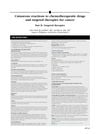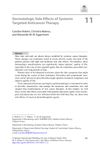TLDR Blocking IL-8 can reduce skin rashes from cancer treatment.
Epidermal growth factor receptor (EGFR) inhibitors, used in cancer treatment, were associated with dermatological adverse reactions like papulopustular rash, which could limit dosage and affect treatment compliance. The study developed a model using healthy volunteers injected with the anti-EGFR monoclonal antibody zalutumumab to induce a rash similar to those caused by systemic EGFR inhibitors. The research found that neutrophils, attracted by IL-8, played a central role in the rash's development. Treatment with HuMab-10F8, a neutralizing antibody against IL-8, reduced the rash, suggesting that IL-8 inhibition could alleviate these dermatological side effects.
53 citations
,
July 2009 in “Cancer Research” Blocking certain proteins can reduce skin inflammation caused by cancer treatment.
193 citations
,
June 1990 in “Journal of Investigative Dermatology” 323 citations
,
November 1984 in “Journal of Investigative Dermatology”
1 citations
,
February 2020 in “The Journal of clinical investigation/The journal of clinical investigation” Certain cancer drugs interact with skin bacteria to cause acne-like rashes.
 29 citations
,
September 2017 in “Oncology and therapy”
29 citations
,
September 2017 in “Oncology and therapy” The document provides advice on how to recognize and treat skin-related side effects of cancer drugs known as EGFR inhibitors.
 88 citations
,
July 2014 in “Journal of the American Academy of Dermatology”
88 citations
,
July 2014 in “Journal of the American Academy of Dermatology” Targeted cancer therapies often cause skin reactions, so dermatologists must manage these effects.
 January 2018 in “Springer eBooks”
January 2018 in “Springer eBooks” Cancer treatments targeting specific cells often cause skin, hair, and nail problems, affecting patients' lives and requiring careful management.
 18 citations
,
January 2017 in “Postępy Dermatologii i Alergologii”
18 citations
,
January 2017 in “Postępy Dermatologii i Alergologii” EGFR inhibitors can cause various skin issues during cancer treatment, and managing these is important for patient care.





